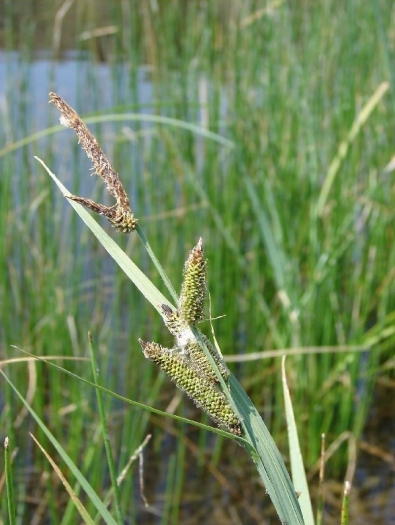Nebraska Sedge
(Carex nebraskensis)
Nebraska Sedge (Carex nebraskensis)
/
/

Sheri Hagwood
Public domain
Image By:
Sheri Hagwood
Recorded By:
Copyright:
Public domain
Copyright Notice:
Photo by: Sheri Hagwood | License Type: Public domain | License URL: https://creativecommons.org/public-domain/ | Uploader: Stickpen | Publisher: Wikimedia Commons | Title: Carexnebrascensis.jpg | Notes: |

Estimated Native Range
Summary
Carex nebraskensis, commonly known as Nebraska Sedge, is a semi-deciduous perennial grass native to wet meadows, stream banks, and riparian zones across the Central and Western USA and Canada. It typically grows to a height of 1-2 feet (30-60 cm) with a similar spread, forming dense clumps of narrow, grass-like leaves. The plant produces inconspicuous greenish-brown flowers in late spring to early summer, which are followed by seed heads that can persist into fall. The foliage may remain evergreen in milder climates.
Nebraska Sedge is valued for its ability to stabilize soil and prevent erosion along waterways. It is often used in rain gardens, bioswales, and as a naturalizing element in wetland restoration projects. Its preference for moist to wet conditions makes it suitable for planting in areas with poor drainage. While it thrives in full sun to part shade, it requires consistently moist to wet soil to perform well. Nebraska Sedge is relatively low maintenance, but it can spread vigorously in ideal conditions, potentially becoming invasive in garden settings.CC BY-SA 4.0
Nebraska Sedge is valued for its ability to stabilize soil and prevent erosion along waterways. It is often used in rain gardens, bioswales, and as a naturalizing element in wetland restoration projects. Its preference for moist to wet conditions makes it suitable for planting in areas with poor drainage. While it thrives in full sun to part shade, it requires consistently moist to wet soil to perform well. Nebraska Sedge is relatively low maintenance, but it can spread vigorously in ideal conditions, potentially becoming invasive in garden settings.CC BY-SA 4.0
Plant Description
- Plant Type: Grass
- Height: 1-2.5 feet
- Width: 1-2 feet
- Growth Rate: Moderate
- Flower Color: N/A
- Flowering Season: Summer
- Leaf Retention: Semi-Deciduous
Growth Requirements
- Sun: Full Sun, Part Shade
- Water: High
- Drainage: Slow, Medium
Common Uses
Bird Garden, Deer Resistant, Low Maintenance, Rabbit Resistant, Street Planting, Water Garden
Natural Habitat
native to wet meadows, stream banks, and riparian zones across the Central and Western USA and Canada
Other Names
Common Names: James’ Sedge
Scientific Names: , Carex nebraskensis, Carex nebrascensis var. ultriformis, Carex nebraskensis var. eruciformis, Carex jamesii var. nebraskensis, Carex jamesii var. ultriformis, Carex nebraskensis var. praevia, Carex nebraskensis var. ultriformis,
GBIF Accepted Name: Carex nebraskensis Dewey